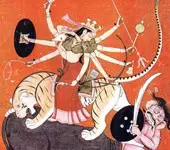18.8K
Likes
995
Comments
Recommended for you
The greatness of Ganga
 Click here to know more..
Click here to know more..
Bala and Atibala Mantras - Sriram Ji will unfold their superpower

The 22nd sarga of Bala Kanda of Valmiki Ramayana. Vishwamitra came to Ayodhya to ask Dasharatha to send young Sriram Ji along with him. ....
Click here to know more..Bhaja Govindam

भज गोविन्दं भज गोविन्दं गोविन्दं भज मूढमते। संप्राप्ते �....
Click here to know more..
English Topics
Devi Mahatmyam
Click on any topic to open
- 49 Devi's Presence in Kindness, Contentment, and Nurturing
- 48 Durga as Lakshmi. Vritti, and Smriti
- 47 Why Devi is called Shanti
- 46 Why Is Devi Called Kshanti?
- 45 Meaning of Trishna In Durga Saptashati
- 44 Why Is Devi Called Hunger?
- 43 Difference Between Chetana And Buddhi
- 42 Why Devi Is Called Durga?
- 41 What Are The Eight Siddhis?
- 40 Namo Devyai Mahadevyai - Why Is She Called Devi And Mahadevi?
Please wait while the audio list loads..
30
Ganapathy
Shiva
Hanuman
Devi
Vishnu Sahasranama
Mahabharatam
Practical Wisdom
Yoga Vasishta
Vedas
Rituals
Rare Topics
Devi Mahatmyam
Glory of Venkatesha
Shani Mahatmya
Story of Sri Yantra
Rudram Explained
Atharva Sheersha
Sri Suktam
Kathopanishad
Ramayana
Mystique
Mantra Shastra
Bharat Matha
Bhagavatam
Astrology
Temples
Spiritual books
Purana Stories
Festivals
Sages and Saints
26
15
13
Copyright © 2024 | Vedadhara | All Rights Reserved. | Designed & Developed by Claps and Whistles
